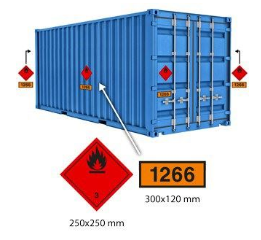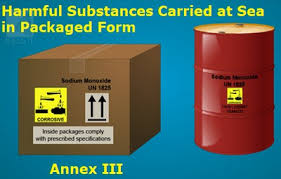Uncover the vital role of MARPOL Annex III in regulating harmful substances transported in packaged form. Learn about its rules, classifications, documentation, and global enforcement in this detailed guide.
Shipping is not just about transporting bulk oil or chemicals—it also involves thousands of packaged goods, many of which can be hazardous. From batteries and pesticides to paints and aerosols, these substances pose serious risks to marine life if not properly managed. This is where MARPOL Annex III becomes indispensable. It addresses the pollution risks associated with harmful substances carried in packaged form, providing a regulatory framework for safe maritime transport.


Annex III is a lesser-known but highly important part of the International Convention for the Prevention of Pollution from Ships (MARPOL 73/78). It complements other annexes by focusing on cargo that is not carried in bulk but rather in containers, drums, cylinders, or tanks. Let’s explore why it matters, how it works, and what it means for the future of safe maritime shipping.
Why MARPOL Annex III Matters in Modern Shipping
While oil spills and bulk chemical discharges often grab headlines, the mishandling of packaged dangerous goods presents a quieter, persistent threat. In 2023, over 17 million TEUs (twenty-foot equivalent units) of containerized cargo were shipped globally, many containing hazardous materials (HazMat), according to Clarksons Research. Improper packing, stowage, or labeling of these substances has led to severe accidents, including ship fires, port explosions, and marine contamination.
Annex III establishes clear rules to prevent marine pollution from the accidental release of harmful substances. It also strengthens synergy with the International Maritime Dangerous Goods (IMDG) Code, published by the IMO, ensuring that cargo operations remain safe and environmentally responsible.
Scope and Application of MARPOL Annex III
Annex III applies to all ships carrying harmful substances in packaged form, including those in freight containers, portable tanks, road tank vehicles, and rail wagons transported aboard ships.
Its core principles revolve around:
- Packaging standards
- Marking and labeling
- Documentation
- Stowage requirements
- Emergency response procedures
All requirements align closely with the IMDG Code, which is mandatory under SOLAS Chapter VII and recognized globally.
Definition of Harmful Substances
Annex III defines a harmful substance as:
“a substance which is identified as a marine pollutant in the IMDG Code or which meets the criteria in the appendix to Annex III.”
Such substances are marked with the marine pollutant symbol (dead fish and tree) on packaging.
Packaging and Labelling
To prevent leakage and environmental damage, packaging must:
- Be durable, leakproof, and suitable for maritime transport.
- Bear proper labels, including the UN number, hazard class, and marine pollutant symbol.
- Conform to the UN Recommendations on the Transport of Dangerous Goods.
Documentation
Every consignment must include a declaration of dangerous goods, stating:
- Proper shipping name
- Class and UN number
- Quantity and packaging group
- Emergency contact information
Documentation must be retained on board and made available to Port State Control inspectors.
Stowage and Segregation
Improper stowage can lead to chain reactions in the event of leaks, heat exposure, or water ingress. The IMDG Code provides detailed guidelines on:
- Deck vs. hold stowage
- Segregation from foodstuffs
- Temperature control for reactive chemicals
- Incompatibility management
–
Real-World Examples and Incidents
Case 1: MSC Flaminia Fire (2012)
One of the most catastrophic incidents related to packaged dangerous goods was the explosion aboard the MSC Flaminia, caused by improperly declared divinylbenzene. Three crew members died, and the ship burned for weeks in the North Atlantic. The investigation exposed serious failures in declaration, packaging, and stowage of Annex III substances.
Case 2: Beirut Port Explosion (2020)
Although not directly under Annex III, the Beirut port explosion, caused by ammonium nitrate, spotlighted the dangers of poor storage and documentation. It led many flag states and port authorities to revisit their handling of Annex III materials.
Enforcement and Global Compliance
Annex III is enforced by:
- Flag States (ensuring vessels flying their flag comply)
- Port State Control regimes like Paris MoU, Tokyo MoU, and USCG
- National maritime authorities, such as AMSA (Australia), MCA (UK), and Transport Canada
In 2022, Paris MoU reported that 16% of vessel detentions were linked to improper cargo documentation or hazardous cargo handling.
Technologies like Equasis, MarineTraffic, and VesselFinder now assist port states in pre-screening vessels for risk profiles, improving compliance.
Integration with Other Codes and Frameworks
Annex III doesn’t operate in isolation. It’s deeply integrated with:
- SOLAS – especially Chapter VII (Dangerous Goods)
- IMDG Code – serves as the operational manual for Annex III
- ILO/IMO/UNECE Code of Practice for Packing of Cargo Transport Units (CTU Code)
- GHS (Globally Harmonized System of Classification and Labelling of Chemicals)
Together, these frameworks provide a robust multilayered safety net.
–
Challenges and Solutions
1. Misdeclaration and Fraud
Shippers sometimes intentionally misdeclare hazardous cargo to avoid costs. Authorities have responded by introducing stricter penalties and random inspections. Technologies like blockchain documentation are also gaining traction for tamper-proof cargo records.
2. Crew Training
Lack of knowledge among crew can lead to mishandling. Lloyd’s Maritime Academy, The Nautical Institute, and IMAREST offer specialized training for HazMat handling and emergency response.
3. Incident Response Readiness
Despite regulations, accidents happen. Companies like Inmarsat now offer real-time emergency support tools via satellite, improving response time in remote ocean areas.
Future Outlook for MARPOL Annex III
The next decade will likely see:
- Full digitization of hazardous cargo documentation.
- Harmonization between Annex III and other conventions (e.g., Basel Convention on hazardous waste).
- Use of AI to detect anomalies in cargo declarations.
- Greater emphasis on green chemistry and alternatives to hazardous materials.
The IMO’s Strategy on Reducing Marine Litter (2025 Update) may also include tighter control of plastic-based packaging, currently a growing concern.
–
Frequently Asked Questions (FAQ)
1. What does MARPOL Annex III regulate?
It governs the transport of harmful substances in packaged form to prevent marine pollution.
2. What is considered a harmful substance?
A substance classified as a marine pollutant under the IMDG Code or meeting criteria in the Annex III appendix.
3. Is Annex III applicable to bulk cargo?
No, it only applies to packaged substances—bulk liquids are regulated under Annex II.
4. How is compliance checked?
Through Port State Control inspections, cargo documentation reviews, and on-board stowage checks.
5. What are common violations?
Misdeclaration of goods, poor labeling, and improper packaging or stowage.
6. Who is responsible for compliance?
Responsibility is shared among shippers, carriers, terminal operators, and ship masters.
7. How can I get training in Annex III regulations?
Training is available via IMO e-learning, Lloyd’s Maritime Academy, and The Nautical Institute.
–
Conclusion
MARPOL Annex III may operate behind the scenes, but its impact is anything but minor. As the global shipping network expands and container traffic increases, so do the risks tied to harmful substances in packaged form. With growing pressure on environmental accountability, compliance with Annex III is no longer optional—it’s an operational necessity.
Whether you’re a deck officer, cargo planner, regulatory official, or maritime student, understanding Annex III is critical to ensuring safe seas and responsible shipping. The future of maritime logistics is not just faster and bigger—it must also be safer and cleaner.
References
- IMO – MARPOL Annex III Overview
- IMDG Code
- Paris MoU Annual Reports
- Clarksons Research – Container Statistics
- Lloyd’s Maritime Academy
- Equasis Ship Data
- Wikimedia Marine Pollutant Symbol
- Inmarsat Emergency Services
- CTU Code
- GHS Classification
- ILO/IMO Guidelines for Packing of Cargo Transport Units
- Marine Pollution Bulletin – Elsevier
✅ MULTIPLE CHOICE QUESTIONS (MCQs)
1. What is the main objective of MARPOL Annex III?
A. Prevent air pollution from ship engines
B. Prevent pollution from harmful substances in packaged form
C. Prevent sewage discharge from ships
D. Regulate bulk oil transportation
Correct Answer: B. Prevent pollution from harmful substances in packaged form
2. MARPOL Annex III applies to harmful substances transported in:
A. Bulk liquid form only
B. Packaged form (containers, drums, cylinders, etc.)
C. Ballast tanks
D. Fuel tanks
Correct Answer: B. Packaged form (containers, drums, cylinders, etc.)
3. Which international code works alongside Annex III to manage packaged hazardous cargo?
A. IGC Code
B. ISM Code
C. IMDG Code
D. Polar Code
Correct Answer: C. IMDG Code
4. What symbol is used to mark marine pollutants under Annex III?
A. Flame over circle
B. Exploding bomb
C. Skull and crossbones
D. Dead fish and tree
Correct Answer: D. Dead fish and tree
5. Which of the following is NOT a requirement under Annex III?
A. Durable, leakproof packaging
B. Marking and labeling
C. Cargo Record Book for bulk chemicals
D. Dangerous goods declaration
Correct Answer: C. Cargo Record Book for bulk chemicals
(This is required under Annex II, not Annex III)
6. What incident involved improperly declared packaged cargo that led to a deadly shipboard explosion in 2012?
A. Beirut Port Explosion
B. MSC Flaminia Fire
C. Exxon Valdez
D. Torrey Canyon Grounding
Correct Answer: B. MSC Flaminia Fire
7. What are common violations of Annex III regulations?
A. Speeding violations
B. Poor anchorage discipline
C. Misdeclared goods, improper labeling, bad stowage
D. Unclean ballast tanks
Correct Answer: C. Misdeclared goods, improper labeling, bad stowage
8. MARPOL Annex III is enforced by:
A. The United Nations General Assembly
B. Flag States and Port State Control
C. The International Tribunal for the Law of the Sea
D. IMO’s Legal Committee
Correct Answer: B. Flag States and Port State Control
9. What system is used by ports to report their capabilities and cargo risk profiles?
A. SOLAS Tracker
B. IMO Ballast Database
C. GISIS
D. NAVTEX
Correct Answer: C. GISIS
10. What trend is likely in the future for Annex III compliance?
A. Ban on refrigerated cargo
B. Fully paper-based documentation
C. Digital records and AI cargo screening
D. Removal of all marine pollutant restrictions
Correct Answer: C. Digital records and AI cargo screening
✅ TRUE/FALSE QUESTIONS
1. MARPOL Annex III regulates harmful substances carried in bulk liquid form.
False
Explanation: It regulates harmful substances in packaged form. Bulk liquids fall under Annex II.
2. The IMDG Code is mandatory and forms the operational basis of Annex III.
True
3. Marine pollutants under Annex III must be clearly labeled with a specific symbol.
True
Explanation: The symbol is a dead fish and tree icon.
4. Annex III applies only to container ships over 10,000 GT.
False
Explanation: It applies to all ships carrying harmful substances in packaged form, regardless of size.
5. Misdeclaration of hazardous cargo can lead to vessel detention or fines.
True
6. The 2020 Beirut Port Explosion is an example of Annex III enforcement.
False
Explanation: While relevant, it involved ammonium nitrate stored ashore, not a direct MARPOL Annex III case.
7. The CTU Code helps guide proper packing and securing of dangerous goods for transport.
True
8. SOLAS and GHS have no relation to MARPOL Annex III.
False
Explanation: SOLAS (Chapter VII) and GHS classification support and complement Annex III regulations.
9. Inadequate crew training can increase the risk of Annex III violations.
True
10. Blockchain is being explored to create tamper-proof cargo documentation systems.
True
